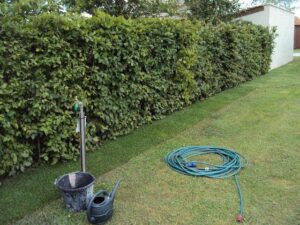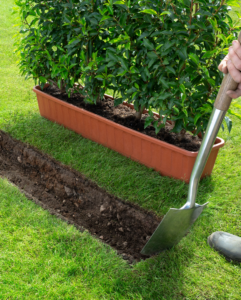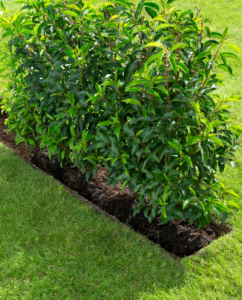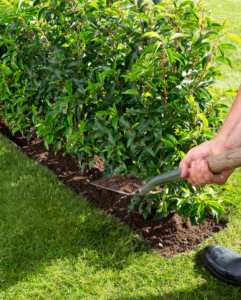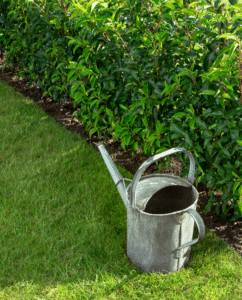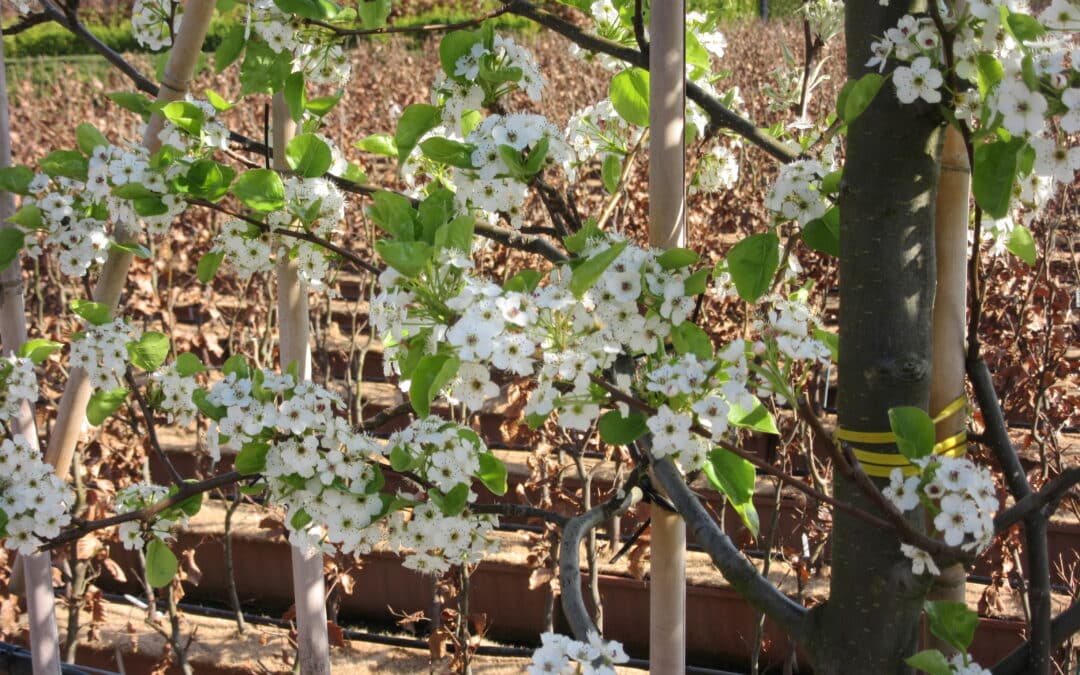
by Gabi Cox | Mar 18, 2024 | News
Readyhedge is known for being a grower of high quality instant hedging but did you know that we also grow nearly 1000 pleached trees each year. Starting with a feathered tree our team of skilled staff train the trees onto a bamboo frame and then grow them on for at least one growing season before they are offered for sale.
The team grow over 10 different species in both evergreen and deciduous and with clear stem heights from 0-180cm.
So how do pleached trees work?
Pleached trees are an amazing addition to a garden and allow for screening to over 3 metres, especially when planted next to a fence or a wall. Having the clear stem allows for the beauty of a natural wall to be seen or the opportunity for decorative planting underneath. While pleached trees are most often used along a boundary to give extra privacy, they can also be used to great effect as free standing features and can be seen in some well known formal gardens in Britain, commonly forming avenues or framing linear water features.
It is hard to pick a favourite out of the trees that we grow at Readyhedge, but we feel the three below are the best deciduous and evergreen screening panels that we grow.
Readyhedge Top Three Deciduous Pleached Trees
Carpinus betulus (Hornbeam)
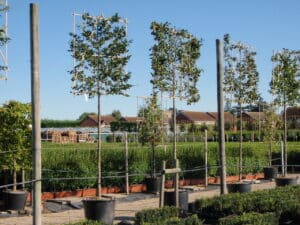
The Hornbeam is one of the most versatile hedging plants that you can find and as a pleached tree it is just as good. Happy growing in all soil types, this variety will perform reliably every year. With lovely fresh green leaves in the spring and retaining a proportion of its old leaves during the winter, it is a great all rounder. With at least a 150cm clear stem, when grown as an aerial screen you get to see the amazing buttresses of the stem, which are normally hidden when grown as hedging. Due to its ease of growth this is the perfect variety to choose for areas where aftercare may be limited.
Pyrus cal. Chanticleer (Ornamental Pear)
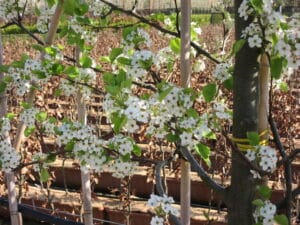
This is a very underrated tree. While it is deciduous, it is one of the last trees to lose its leaves on the nursery, regularly still having leaves in December before coming back into the leaf very early as well. It also has copious quantities of white flowers in the spring which are already fully out this year (early March), which are then followed by the leaves.
While it is a member of the Pear family it does not often set fruit and when it does they are very small and insignificant. The flowers in the spring are amazing but in the Autumn, it’s fiery colour is breathtaking and on a good year could nearly rival the Japanese maples for its colour.
Liquidamber Worplesdon (Sweet Gum)
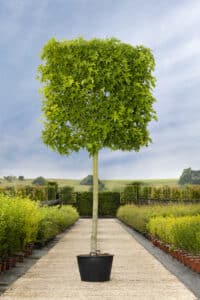
Often confused with the Japanese Maples due to its five lobed leaves, it has a similar autumn colour. The leaves are large and lobed and come out a fresh green in the late spring and if crushed they give out a sweet menthol/eucalyptus scent. Having large leaves means that this type always seems to give you good coverage and privacy from a young age, which can make it a very good choice if you don’t want to wait for an established tree. To add to its beauty, the older branches and trunk can have a corky winged appearance.
Readyhedge Top Three Evergreen Pleached Trees
Prunus lau. Novita
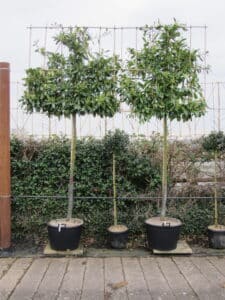
A form of Cherry or Common Laurel, this large leaf evergreen is a great all purpose screening tree. Suitable for nearly all areas and soil types it will happily grow a good dense head. Regular pruning is required to keep it looking at its best as well as removing the white candle like flowers as they fade if you do not want it to produce fruit.
Prunus lus. Angustifolia (Portugal Laurel)
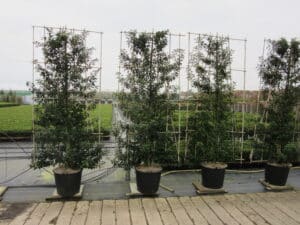
As a standard hedge the Portugal is a firm favourite due to its ability to be trimmed up into formal shapes and dense look. As a pleached tree it is no different and just as stunning. If a high class finish is required this is the go to tree.
Quercus ilex (Holm Oak)
An evergreen British native oak tree with a different grey green leaf, the Holm Oak is very slow to get going and to form a screen but when it does it is amazing. We grow a limited number of these and normally only get up to about a 120cm clear stem. They require some patience and imagination on behalf of a client but for those with the foresight they will be rewarded with a dense pleached tree that is capable of being trimmed up into a very formal finish if that is what is required
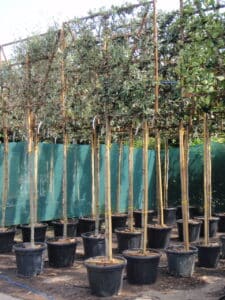
Whichever final look you want to achieve and garden space you’re working with, Readyhedge has a whole host of pleached tree options for you. It’s always worth getting in touch and speaking to the team, as we often have various options of some varieties that will not necessarily appear on the website and possibly not even the stock list.
Get in touch with the team here, we can’t wait to hear from you!
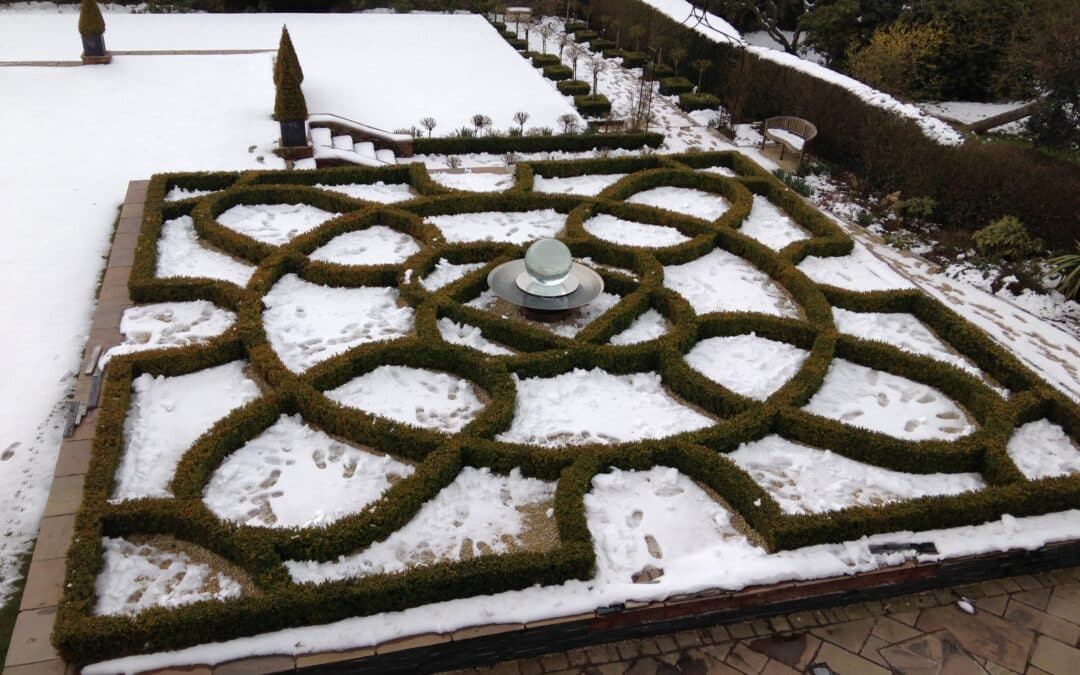
by Gabi Cox | Feb 23, 2024 | News
At Readyhedge, we provide hedging of all shapes and sizes, catering to every type of outdoor space. We know that sometimes all that is needed is a small divider in a garden and this is where the low hedges come in.
Low hedging tends to be evergreen, meaning they can add structure to the garden even in the depths of winter. Best known as knot gardens or Parterres in the grand country houses of the rich and famous, where they are planted in between colourful bedding plants, they are just as useful in a small garden to edge a path or patio to give the garden structure.

In our previous blog post, we discussed all things low hedging including how to incorporate them into your garden, maintenance tips and how to ensure sustainability. Below we look at our top 5 low hedge picks for your garden.
Low Hedge 1: Buxus sempervirens (Common Box)
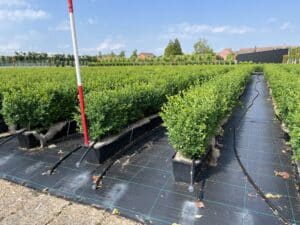
This is the classic low hedge that has been grown for hundreds of years. It is a very slow growing hedge and with two trims a year it can be kept looking amazing. With small evergreen leaves it forms a dense hedge that can be kept at 40cm in height with great ease. It grows 2 – 5 cm a year and over time can grow up to over 180cm in height, although this would take a while.
Currently suffering from bad press because of a box moth caterpillar and the potential effects of blight. The Buxus sempervirens are still a brilliant hedge and with care and treatment both of these problems can be, and are, kept at bay allowing this plant to thrive as an amazing low hedge option.
Low Hedge 2: Taxus baccata (English Yew)
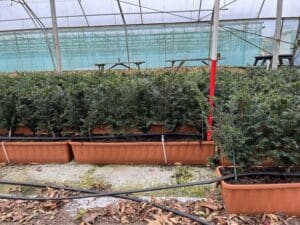
A surprising one as normally seen as a large hedge in a formal garden or even a maze. With regular trimming the English Yew can be kept down to around 40 – 50cm in height. With its dark green foliage it makes a great edge to an outdoor space and also makes for a stunning backdrop for other plants. Good for a Knot garden, it is worth considering as a low hedge as it is easy to get topiary shapes like balls, cones and Pyramids to match up with it. If it does get too big it is possible to cut Taxus down and it will regenerate to form a nice low hedge again.
Low Hedge 3: Euonymus Jean Hugues
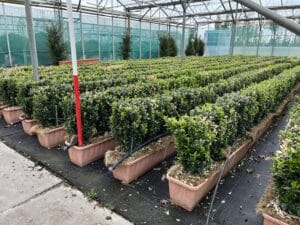
A relatively new hedge form, this plant is making a big inroad into the low, formal hedge market. Evergreen with small green leaves, they are thinner and not as rounded as Box leaves are but still look just as great. At Readyhedge we have been growing this hedge for 5 to 6 years and it can grow up to 80cm tall quite quickly although it is also easy to keep it cut down to around 40-50cm. We would not advise planting this in a really exposed site but we are finding that in more sheltered spots it is a brilliant performing low hedge.
Low Hedge 4: Ilex crenata (Japanese Holly)
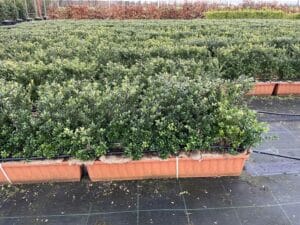
Looking nothing like the holly that you normally see, with small oval leaves and no spines, this is an interesting and slightly different hedge type. As it gets older it gets denser meaning at a young age it can look a bit open but as it matures it fills out and eventually forms a really dense screen.
We grow two types, the first is an Ilex crenata Dark Green which is normally around 30-40cm tall with a lovely dark green leaf. The other is Ilex crenata Caroline Upright which grows taller and has a paler more yellow leaf and this makes a superb hedge in the 70-90cm height range. Both of these plants perform best in a loam soil that is also slightly acidic. They are quite a rigid plant and as such it would be best to use them in areas where they are not likely to be knocked into as they can damage very easily.
Low Hedge 5: Pittosporum Golf Ball
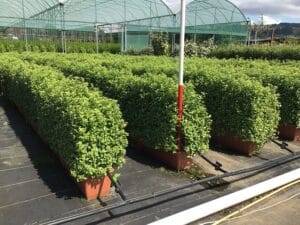
This, as the name suggests, will, if left alone, form a sphere or dome. However, trimmed it makes a lovely low hedge with a pale almost grey green leaf. The Pittosporum Golf Ball tend to be soft looking and not quite as formal as the previous hedges. We would again suggest that these are grown in the milder parts of the country or in sheltered spots as they can show some leaf scorch during the winter.
No matter what look you’re after or the size of your garden, when the right hedge is chosen and planted well, the final outcome can be incredibly effective.
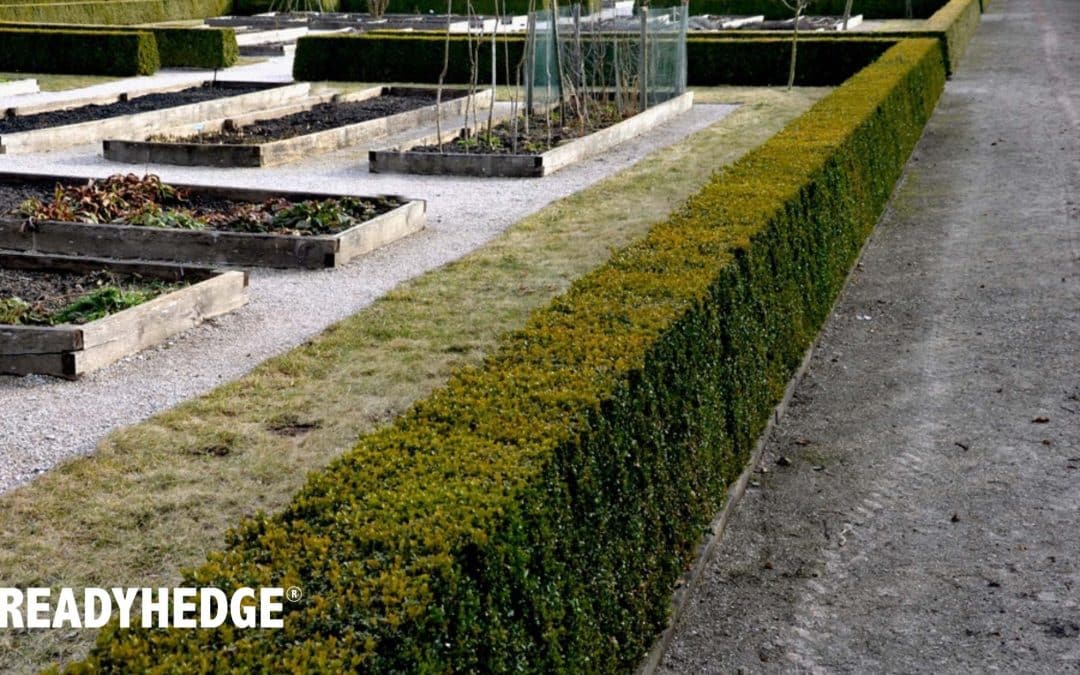
by Matthew Kemble | Jan 24, 2024 | News
The Versatile World of Low Hedging: Ideas for Every Gardener
Low hedging, an integral component of garden design, offers a unique blend of aesthetics, functionality, and versatility. Perfect for gardeners of all skill levels, low hedges provide a natural solution for defining spaces, enhancing privacy, and adding beauty to landscapes. This blog explores the multifaced world of low hedging, offering ideas and insights to inspire gardeners everywhere.
Understanding Low Hedging:
Low hedges, typically under one metre in height, are much more than just garden borders. They serve multiple purposes: Creating visual interest, delineating spaces, and even serving as windbreaks or noise barriers. The beauty of low hedging lies in its versatility – whether you have a sprawling large garden or a modest front garden, there’s a low hedge to suit your needs.
Choosing the Right Plants:
The key to successful low hedging starts with appropriate plants. Factors such as growth rate, foliage density, and adaptability to your local climate are crucial. Some popular choices include:
• Box (Buxus sempervirens): Known for its dense, evergreen foliage, boxwood is a classic choice for formal low hedging.
• Japanese Holly (Ilex Crenata): A great alternative to boxwood, it’s perfect for creating smooth, rounded hedges.
Designing with Low Hedges
Low hedging offers endless design possibilities, making them suitable for a range of different garden styles:
1. Formal Gardens: Use straight-lined low hedging to create geometric patterns or frame garden statues.
2. Cottage Gardens: Combine flowering plants like lavender with informal hedging for a relaxed, charming effect.
3. Contemporary Spaces: Opt for neatly trimmed hedges like boxwood to complement modern garden designs.
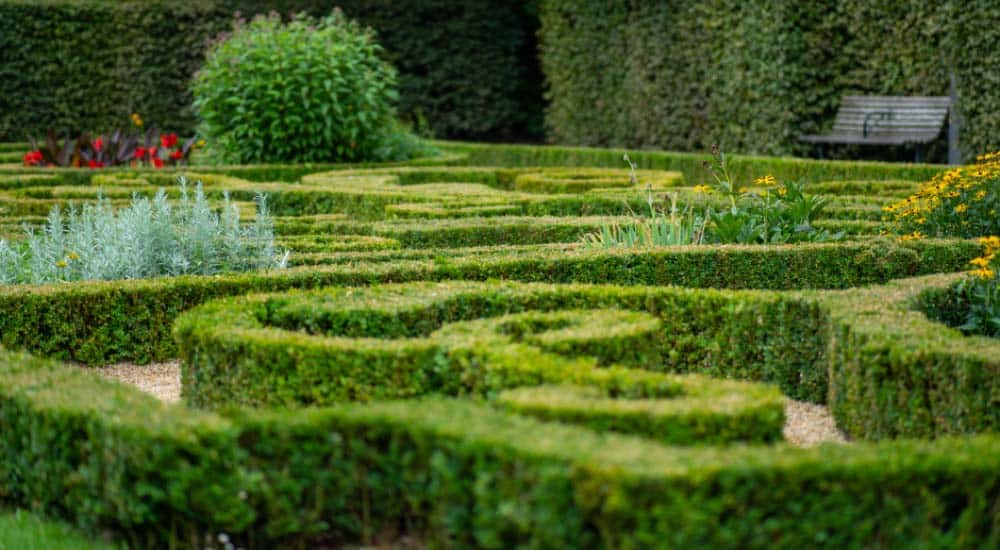
Maintenance Tips:
While low hedges are generally low-maintenance, some care is necessary to keep them looking their best:
• Pruning: Regular pruning not only maintains the desired shape but also encourages dense growth.
• Feeding and Watering: Providing the right nutrients and adequate water will ensure your hedges stay healthy and vibrant.
• Pest and Disease Management: Keep an eye out for common issues like box blight or spider mites and caterpillars and treat them promptly.
Incorporating Low Hedges for Functionality:
Apart from their decorative value, low hedges can be functional:
• Creating Borders: They are ideal for marking the boundaries of vegetable gardens or walkways.
• Wildlife Habitats: Planting native hedges can attract beneficial insects and birds, enhancing your garden’s biodiversity.
Sustainable Gardening with Low Hedges:
Incorporating sustainable practices into your hedging strategy not only benefits the environment but also improves your gardens health:
• Choosing Native Plants: They are better adapted to local conditions and require less care.
• Organic Practices: Use natural fertilisers and pest control methods to minimise environmental impact.
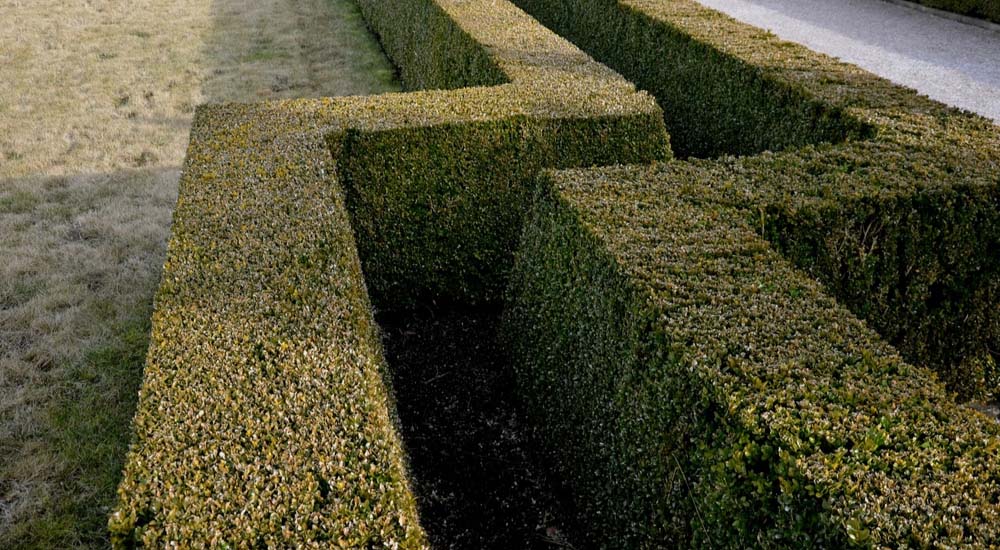
Advanced Techniques:
For the more adventurous gardener, low hedging can be an opportunity to experiment:
• Topiary Art: Skilful pruning hedges into artistic shapes can add a unique touch to your garden.
• Layered Planting: Combining different hedge heights can create a visually appealing and dynamic landscape.
Integrating Low Hedges in Small Spaces and Urban Gardens:
Low hedges are not just for expansive landscapes; they can play a significant role in smaller gardens and urban settings. In compact spaces, low hedges can be used to maximise the sense of space and create distinct areas without overwhelming the area. They are excellent for balcony gardens, patio borders, or green dividers in communal urban spaces. By choosing dwarf varieties or slow-growing plants, urban gardeners can enjoy the elegance of hedges without the need for frequent trimming or maintenance.
The world of low hedging is rich and varied, offering something for every gardener. Whether you’re a seasoned pro or just embarking on your garden journey, low hedging can enhance your garden in a number of ways. From creating defined spaces to attracting wildlife, these versatile plants are a fantastic addition to any garden.
By embracing the ideas shared within this blog, you’re well on your way to discovering the full potential of low hedging in your garden. Remember, gardening is a journey of learning and growth, and low hedging is a wonderful chapter in that adventure.
For more hedging insights and expert advice, please feel free to get in touch with us here at Readyhedge. Our team is dedicated to helping you achieve your gardening/landscaping goals.
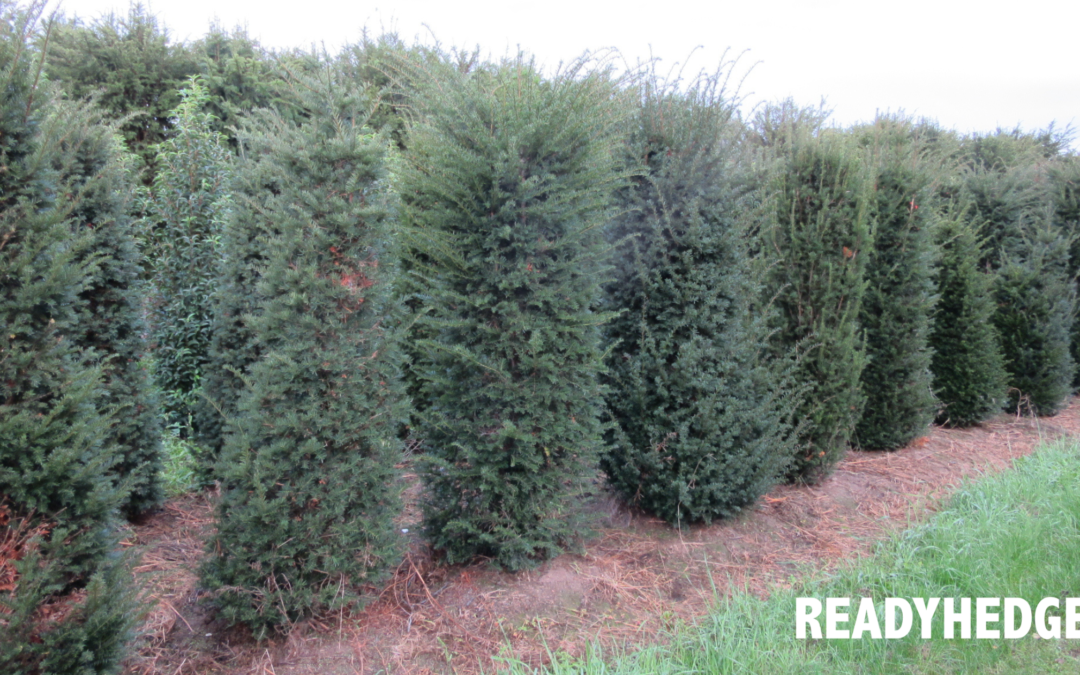
by Matthew Kemble | Dec 12, 2023 | News
Unveiling the Charm of Taxus Hedging in Your Garden
Discover the timeless elegance of Taxus hedging, commonly known as Yew, a distinguished choice for garden enthusiasts. This blog delves into what Taxus is, its benefits, diverse applications in various garden spaces, and essential planting and maintenance tips. Known for its dense, evergreen foliage, Taxus is a popular choice in landscape design, offering both aesthetic appeal and functional benefits.
Benefits of Taxus Hedging
1. Aesthetic Appeal: Taxus hedges offer lush, green backdrops year-round, enhancing garden and landscape aesthetics.
2. Privacy and Noise Reduction: Their dense foliage creates natural privacy screens and sound barriers, ideal for urban settings.
3. Environmental Benefits: Taxus hedges contribute to carbon sequestration and provide habitats for wildlife, these hedges attract a variety of birds and beneficial insects, promoting biodiversity and enriching the garden ecosystem.
4. Versatility in Design: Suitable for both formal and informal designs, they can also be sculpted into various shapes, catering for a multitude of landscape themes.
5. Durability and Low Maintenance: These hedges are resilient to various weather conditions and require minimal upkeep, making them a practical choice for gardeners of all skill levels. If taken care of to a high standard, these hedges could increase the monetary value of your garden.
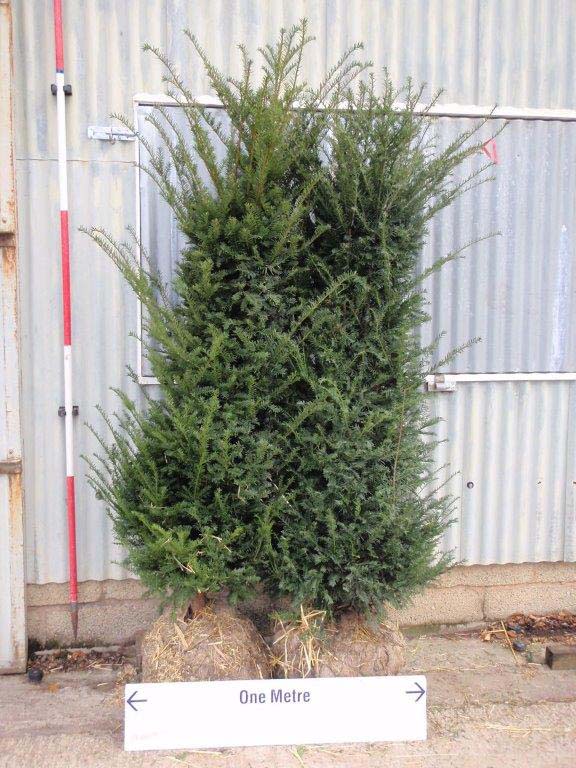
Utilisation in Different Areas
Taxus hedges are versatile, fitting seamlessly into various garden designs. They’re perfect for creating boundary hedges, ornamental topiaries, or as foundational plants in mixed borders. In larger landscapes, they serve as windbreaks or privacy screens. Taxus hedges also find their place in smaller urban gardens, providing greenery and tranquillity amidst bustling cityscapes.
Planting and Maintenance
To ensure the success of your Taxus hedge, consider these tips:
• Planting: Choose well-drained soil and a suitable location with adequate sunlight.
• Watering: Regular watering is important, especially during dry spells.
• Trimming: trim 2 to 3 times per year to help maintain shape and encourages dense growth.
• Disease Management: Watch for signs of root rot or pest infestations and treat promptly.
Taxus hedging is more than just a garden feature; it’s an investment in beauty, privacy, and environmental health. Whether you’re creating a serene garden retreat or enhancing an urban area, Taxus hedges offer a blend of elegance and practicality. Embrace the versatility and benefits of Taxus in your garden for a lasting impact.
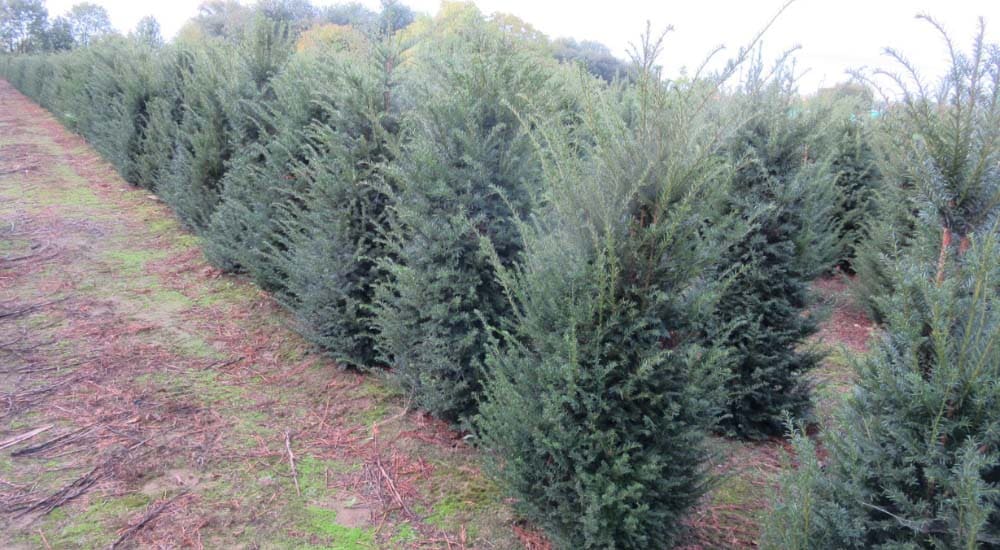
How to buy Taxus Hedging?
Taxus hedging can be bought at this time of the year (and up until the end of March) as Rootballed or Field Grown plants. Rootballed Taxus hedging involves transplanting Taxus, with a substantial soil ball encompassing its root system. This soil ball is then wrapped in a hessian bag which can then also have wire around it depending on the size of the ball. This traditional technique ensures minimal root disturbance, facilitating a smoother transition and healthier growth post transplantation. When planting the wire and hessian are left on the rootball, but are untied from around the stem of the plant, and they will rot away over the course of a couple of years.
The main advantage of buying taxus this way is that you can get bigger and bushier plants than you would from container grown plants.
Contact us today to see what we have to enhance your planting scheme.
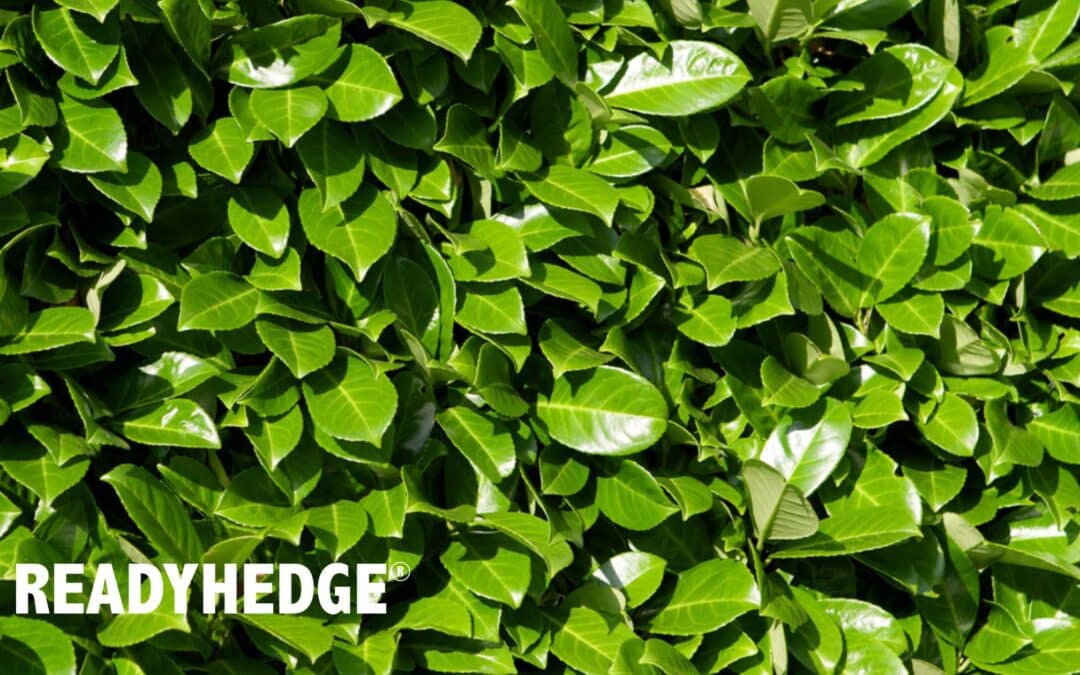
by Matthew Kemble | Dec 8, 2023 | News
Welcome to the vibrant world of gardening, where the charm of evergreen hedges meets the practicality of fast growth! In this article, we’re going to explore the Top 15 Fast Growing Evergreen Hedging Plants in the UK, a selection tailored for those who love to see their gardens flourish quickly and beautifully. Whether you’re a seasoned gardener or just starting out, these plants are a perfect blend of functionality and aesthetics. From providing year-round privacy to enhancing the greenery of your space, these evergreen hedges are the unsung heroes of the garden. So, grab your gardening gloves as we delve into a world of lush, fast-growing hedges that promise to transform your garden into a living masterpiece, all while thriving in the unique UK climate.
What Makes a Good Evergreen Hedge?
Imagine a hedge that’s not only a privacy screen but a living work of art. That’s what a good evergreen hedge brings to your garden. These plants are the stalwarts of the garden, standing strong through all seasons. The best part? Fast-growing varieties mean you don’t have to wait ages to see your green dreams come to life!
Benefits of Evergreen Hedging in the UK
Beyond their beauty, evergreen hedges are a powerhouse of benefits. They’re like nature’s own air purifiers, absorbing pollution and exhaling fresh air. They provide a cozy shelter for birds and beneficial insects. And let’s not forget the privacy and wind protection they offer, making your garden a serene sanctuary.
Top 15 Fast Growing Evergreen Hedging Plants in the UK
|
Plant
|
Soil Type |
Climate |
Sunlight
|
|
Cherry Laurel
|
Well-drained |
Temperate |
Full sun to shade |
|
Leyland Cypress
|
Loamy |
Maritime |
Full sun
|
|
Boxwood
|
Sandy |
Continental |
Partial sun to sun |
| Holly |
Moist, well-drained |
Temperate |
Full sun to shade
|
|
Privet
|
Loamy |
Maritime |
Full sun to shade |
|
Laurel
|
Well-drained |
Continental |
Partial sun to sun
|
| Yew |
Well-drained |
Temperate |
Partial sun to sun
|
|
Escallonia
|
Loamy |
Maritime |
Full sun to partial sun |
| Portuguese Laurel |
Well-drained |
Continental |
Full sun to shade
|
|
Griselinia
|
Loamy |
Maritime |
Full sun to partial sun |
| Photinia |
Well-drained |
Temperate |
Full sun to partial sun
|
|
Berberis
|
Sandy |
Continental |
Full sun to partial sun |
| Bamboo |
Well-drained |
Maritime |
Full sun to partial sun
|
|
Osmanthus
|
Loamy |
Temperate |
Partial sun to sun
|
| Escallonia |
Well-drained |
Maritime |
Full sun to partial sun
|
Plant 1: Cherry Laurel (Prunus laurocerasus)
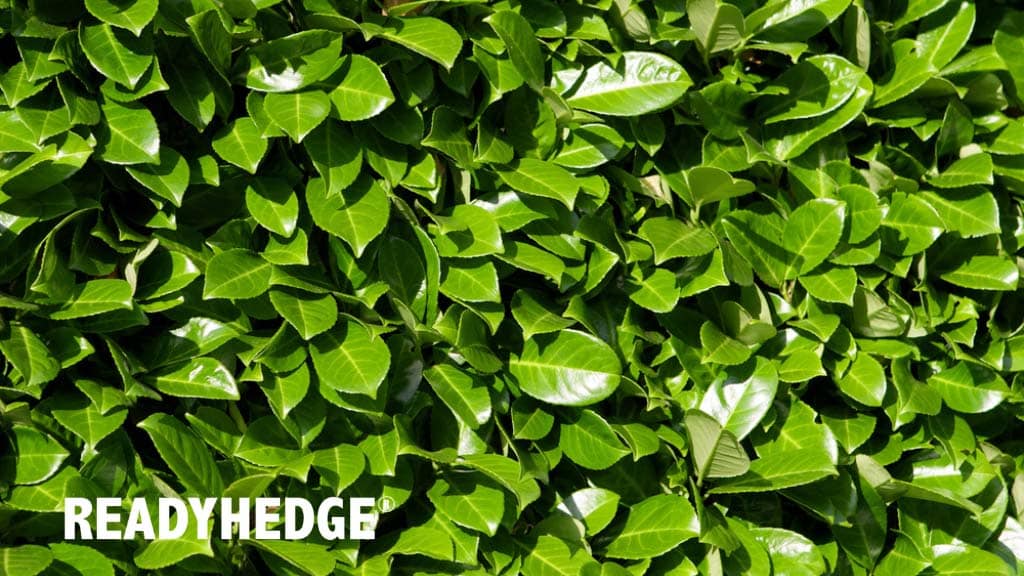
Description: Cherry Laurel is a versatile and popular choice among gardeners in the UK. With its glossy, dark green leaves and fragrant white flowers, it adds an elegant touch to any garden. It’s known for its dense growth, making it an excellent option for creating privacy and wind protection.
Growth Rate: Cherry Laurel is a fast grower, capable of adding up to 24 inches of new growth each year. It can reach a maximum height of 20 feet, creating a substantial hedge relatively quickly.
Ideal Growing Conditions: This adaptable plant thrives in well-drained soil and can tolerate a wide range of sunlight conditions, from full sun to partial shade. It’s well-suited to the varying climates of the UK.
Benefits as a Hedge: Cherry Laurel is an excellent choice for privacy hedges, thanks to its dense foliage. It also provides effective wind protection, making it ideal for coastal regions. Its evergreen nature ensures your garden remains vibrant year-round.
Considerations: While Cherry Laurel is a fantastic hedge plant, it may require regular pruning to maintain its shape and size. Additionally, it’s essential to note that all parts of this plant are toxic if ingested, so exercise caution if you have pets or small children.
Plant 2: Leyland Cypress (x Cupressocyparis leylandii)
Description: Leyland Cypress is a popular choice for gardeners seeking rapid growth and a tall, dense hedge. It features feathery, dark green foliage that creates a lush backdrop in any garden setting.
Growth Rate: If you’re looking for quick results, Leyland Cypress won’t disappoint. It can grow at a remarkable rate of up to 36 inches per year, and in ideal conditions, it can reach an impressive height of 60 feet.
Ideal Growing Conditions: This conifer prefers loamy soil and thrives in full sun. Its tolerance to different soil types makes it a versatile option for many gardens in the UK.
Benefits as a Hedge: Leyland Cypress’s rapid growth makes it an excellent choice for those who want fast coverage and a natural windbreak. Its dense foliage provides privacy and serves as an effective sound barrier.
Considerations: To keep Leyland Cypress in check and prevent overgrowth, regular pruning is essential. Without proper maintenance, it can become unwieldy. However, with proper care, it can be a magnificent addition to your garden.
Plant 3: Boxwood (Buxus sempervirens)
Description: Boxwood is known for its small, dense leaves and its ability to be sculpted into various forms. It adds an elegant and timeless touch to formal gardens and landscapes.
Growth Rate: Boxwood grows at a moderate pace, typically adding around 6 inches of new growth per year. It reaches a maximum height of about 15 feet, making it suitable for various hedge heights.
Ideal Growing Conditions: Sandy soil is preferred for Boxwood, and it can thrive in both partial sun and full sun, making it versatile for different garden settings.
Benefits as a Hedge: Boxwood’s compact growth and evergreen foliage make it a classic choice for formal hedges. Its ability to be pruned into various shapes and sizes allows for creative landscaping.
Considerations: While Boxwood is an attractive option, it does require regular pruning to maintain its desired shape and prevent overgrowth. Additionally, it can be susceptible to some pests and diseases, so keep an eye out for any signs of trouble.
Plant 4: Holly (Ilex aquifolium)
Description: Holly is a classic evergreen plant known for its spiky, glossy green leaves and bright red berries. It adds a touch of traditional charm to any garden.
Growth Rate: Holly grows steadily, adding about 6 inches of new growth per year. It can reach a height of up to 40 feet when left to grow freely.
Ideal Growing Conditions: This plant prefers moist, well-drained soil and can thrive in both full sun and shade, making it versatile for different garden environments.
Benefits as a Hedge: Holly’s dense growth and spiky foliage create an effective privacy barrier. Its attractive red berries add color and interest during the winter months.
Considerations: While Holly is relatively low-maintenance, it may require occasional pruning to shape and control its size. Be cautious with the spiky leaves, especially if you have children or pets.
Plant 5: Privet (Ligustrum)
Description: Privet is a popular choice for hedging due to its small, dark green leaves and fast growth. It forms a dense and tidy hedge.
Growth Rate: Privet is a rapid grower, adding up to 24 inches of new growth each year. It can reach a height of 15 feet when left untrimmed.
Ideal Growing Conditions: This plant thrives in loamy soil and can adapt to full sun to partial shade conditions, making it suitable for various garden settings.
Benefits as a Hedge: Privet’s fast growth and dense foliage make it an excellent choice for creating privacy and boundaries. It can be easily pruned into different shapes.
Considerations: Regular pruning is essential to keep Privet in check and maintain its shape. It’s generally a hardy and easy-to-care-for option.
Plant 6: Laurel (Prunus laurocerasus)
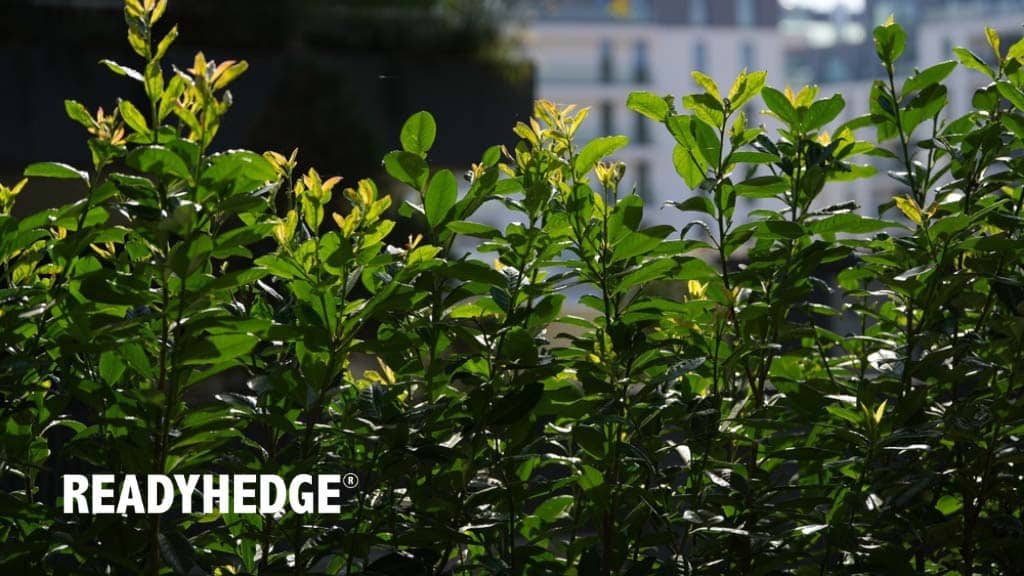
Description: Laurel, also known as Cherry Laurel, features glossy, dark green leaves and a bushy growth habit. It’s a versatile and attractive evergreen plant.
Growth Rate: Laurel grows at a moderate rate, adding about 12 inches of new growth per year. It can reach a maximum height of around 20 feet.
Ideal Growing Conditions: Well-drained soil is ideal for Laurel, and it thrives in partial sun to full sun conditions, adapting well to different lighting.
Benefits as a Hedge: Laurel provides excellent privacy and serves as a beautiful backdrop in your garden. It’s known for its lush and vibrant appearance.
Considerations: Regular pruning may be necessary to maintain the desired shape and size. It’s a low-maintenance option for evergreen hedges.
Plant 7: Yew (Taxus baccata)
Description: Yew is a slow-growing evergreen with dark green foliage and red berries. It’s a long-lived and elegant choice for hedging.
Growth Rate: Yew grows at a modest pace, adding around 6 inches of new growth per year. It can eventually reach a height of up to 60 feet.
Ideal Growing Conditions: Well-drained soil is preferred for Yew, and it thrives in partial sun to full sun conditions, adapting well to different lighting.
Benefits as a Hedge: Yew’s longevity and graceful appearance make it a timeless choice for formal hedges. It’s also deer-resistant, adding to its appeal.
Considerations: Yew requires minimal pruning due to its slow growth, but it’s essential to shape it as needed. Be cautious, as the plant’s seeds and leaves are toxic if ingested.
Plant 8: Escallonia (Escallonia spp.)
Description: Escallonia is a versatile evergreen shrub with small, vibrant green leaves and clusters of colorful flowers. It adds a touch of beauty to any garden.
Growth Rate: Escallonia grows steadily, adding about 12 inches of new growth per year. It typically reaches a height of 6 to 10 feet.
Ideal Growing Conditions: This plant prefers loamy soil and thrives in full sun to partial sun conditions, making it suitable for various garden environments.
Benefits as a Hedge: Escallonia’s vibrant flowers and dense growth create an attractive and colorful hedge. It also attracts pollinators like bees and butterflies.
Considerations: Regular pruning helps maintain the desired shape and size of Escallonia. It’s generally a low-maintenance and rewarding choice.
Plant 9: Portuguese Laurel (Prunus lusitanica)
Description: Portuguese Laurel, also known as Anise Laurel, features glossy green leaves and small fragrant flowers. It’s an elegant evergreen hedge plant.
Growth Rate: Portuguese Laurel grows at a moderate pace, adding about 8 to 12 inches of new growth per year. It can reach a height of up to 20 feet.
Ideal Growing Conditions: Well-drained soil is preferred, and it can thrive in both full sun and shade conditions, adapting well to different lighting.
Benefits as a Hedge: Portuguese Laurel provides an elegant and fragrant backdrop for your garden. It’s known for its versatility and attractive appearance.
Considerations: Regular pruning is recommended to shape and control the size of Portuguese Laurel. It’s generally a low-maintenance option.
Plant 10: Griselinia (Griselinia littoralis)
Description: Griselinia is a fast-growing evergreen shrub with bright green leaves. It’s known for its rapid growth and dense foliage.
Growth Rate: Griselinia is a fast grower, adding up to 24 inches of new growth each year. It can reach a maximum height of 10 to 15 feet.
Ideal Growing Conditions: This plant prefers loamy soil and thrives in full sun to partial sun conditions, making it adaptable to various garden environments.
Benefits as a Hedge: Griselinia’s fast growth and dense foliage make it an excellent choice for creating privacy and boundaries. It forms a lush and vibrant hedge.
Considerations: Regular pruning is essential to maintain the desired shape and size. Griselinia is generally easy to care for and can tolerate coastal conditions.
Plant 11: Photinia (Photinia spp.)
Description: Photinia is a versatile evergreen shrub known for its bright red new growth. It adds a splash of color to your garden.
Growth Rate: Photinia grows steadily, adding about 12 inches of new growth per year. It typically reaches a height of 10 to 15 feet.
Ideal Growing Conditions: Well-drained soil is ideal, and it thrives in full sun to partial sun conditions, allowing for adaptation to different lighting.
Benefits as a Hedge: Photinia’s colorful new growth adds interest and vibrancy to your garden. Its dense foliage also provides privacy.
Considerations: Regular pruning may be necessary to shape and control size. Photinia is generally easy to care for and responds well to pruning.
Plant 12: Berberis (Berberis spp.)
Description: Berberis, also known as
Barberry, is a thorny evergreen shrub with small green leaves and colorful berries. It adds a touch of intrigue to your garden.
Growth Rate: Berberis is a moderately fast grower, adding about 8 to 12 inches of new growth per year. It typically reaches a height of 6 to 10 feet.
Ideal Growing Conditions: Sandy soil is preferred, and it thrives in full sun to partial sun conditions, making it suitable for various garden environments.
Benefits as a Hedge: Berberis’s thorny nature makes it an effective deterrent for intruders. It also attracts birds with its colorful berries.
Considerations: Pruning is recommended to shape and control the size of Berberis. Be cautious of the thorns when handling the plant.
Plant 13: Bamboo (Bambusoideae)
Description: Bamboo is a unique evergreen plant known for its tall, slender stalks and lush foliage. It adds an exotic and tropical feel to your garden.
Growth Rate: Bamboo is a fast grower, with some varieties capable of adding up to 48 inches of new growth each year. Heights can vary significantly, with some reaching over 30 feet.
Ideal Growing Conditions: Well-drained soil is preferred, and bamboo thrives in full sun to partial sun conditions, allowing for adaptation to different lighting.
Benefits as a Hedge: Bamboo forms a dense and visually striking hedge that provides both privacy and an exotic ambiance to your garden.
Considerations: Bamboo can be invasive, so it’s crucial to plant it with containment measures in place. Regular pruning helps maintain its shape.
Plant 14: Osmanthus (Osmanthus spp.)
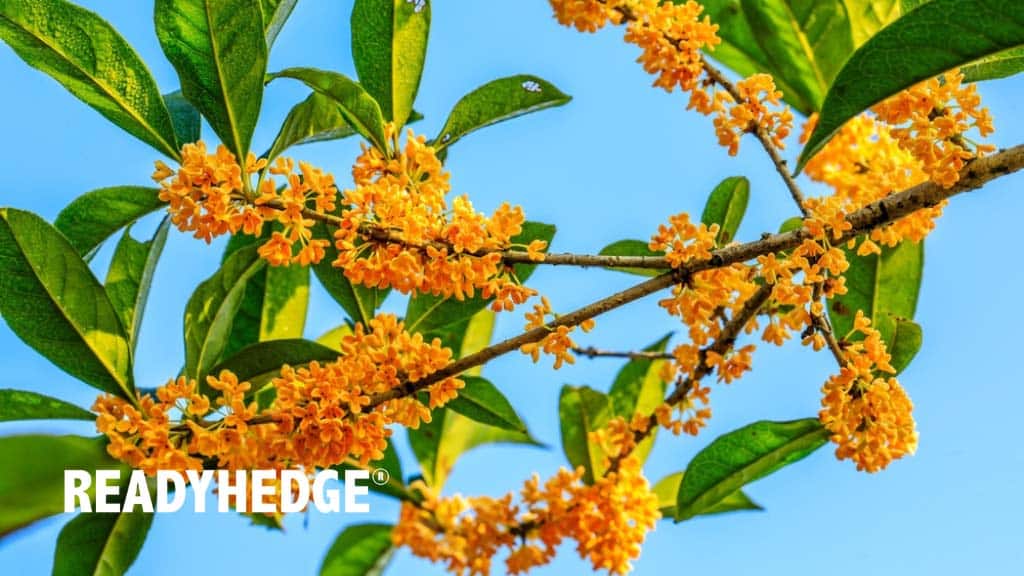
Description: Osmanthus is an elegant evergreen shrub with small, leathery leaves and fragrant flowers. It adds a touch of sophistication to your garden.
Growth Rate: Osmanthus grows steadily, adding about 6 to 8 inches of new growth per year. It typically reaches a height of 6 to 10 feet.
Ideal Growing Conditions: This plant prefers loamy soil and thrives in partial sun to full sun conditions, making it adaptable to various garden environments.
Benefits as a Hedge: Osmanthus’s fragrant flowers and dense growth create an attractive and aromatic hedge that adds charm to your garden.
Considerations: Regular pruning may be necessary to shape and control the size of Osmanthus. It’s generally a low-maintenance option.
Plant 15: Escallonia (Escallonia spp.) (Duplicate Entry)
Description: Escallonia is a versatile evergreen shrub with small, vibrant green leaves and clusters of colorful flowers. It adds a touch of beauty to any garden.
Growth Rate: Escallonia grows steadily, adding about 12 inches of new growth per year. It typically reaches a height of 6 to 10 feet.
Ideal Growing Conditions: This plant prefers loamy soil and thrives in full sun to partial sun conditions, making it suitable for various garden environments.
Benefits as a Hedge: Escallonia’s vibrant flowers and dense growth create an attractive and colorful hedge. It also attracts pollinators like bees and butterflies.
Considerations: Regular pruning helps maintain the desired shape and size of Escallonia. It’s generally a low-maintenance and rewarding choice.
These are the top 15 fast-growing evergreen hedging plants in the UK, each with its unique characteristics and benefits. Consider your garden’s specific needs and aesthetics when selecting the right plant for your hedge project.
Planting and Maintenance Tips for Evergreen Hedges
The journey from a tiny plant to a full-fledged hedge is an exciting one! Planting your evergreen hedge is just the beginning. It’s crucial to give them the right start – think well-draining soil, enough space to grow, and plenty of water in their early days. And remember, a little love and care go a long way in ensuring your hedges remain healthy and vibrant.
Common Problems and Solutions
Even the mightiest hedges face challenges. Common issues include pest infestations, diseases, and environmental stress. Regular checks and early intervention can save your hedge from serious damage. Don’t be afraid to seek advice from local gardening experts – they’re a treasure trove of solutions!
Design Ideas for Evergreen Hedging
Your hedge is your canvas, and the possibilities are endless. Evergreen hedges can be sculpted into formal shapes or left to grow more naturally for a relaxed look. Why not mix different types of hedges for a more dynamic and textured garden design?
Sustainability and Environmental Considerations
As gardeners, we have the opportunity to make a positive impact on the environment. Choosing plants that are native to the UK, conserving water, and avoiding harmful chemicals are just a few ways we can make our gardens eco-friendlier.
Conclusion
And there you have it – a journey through the enchanting world of the “Top 15 Fast Growing Evergreen Hedging Plants in the UK.” Each plant we’ve discussed brings its own unique beauty and benefits, making them ideal choices for creating a vibrant and lively garden boundary. Whether your priority is rapid growth, low maintenance, or year-round greenery, these evergreen hedges offer a solution for every gardening aspiration. We hope this guide has inspired you to bring some evergreen magic to your garden, creating a space that’s not only aesthetically pleasing but also a haven for wildlife and a testament to your green thumb. Happy gardening, and may your hedges grow tall, strong, and beautiful!
